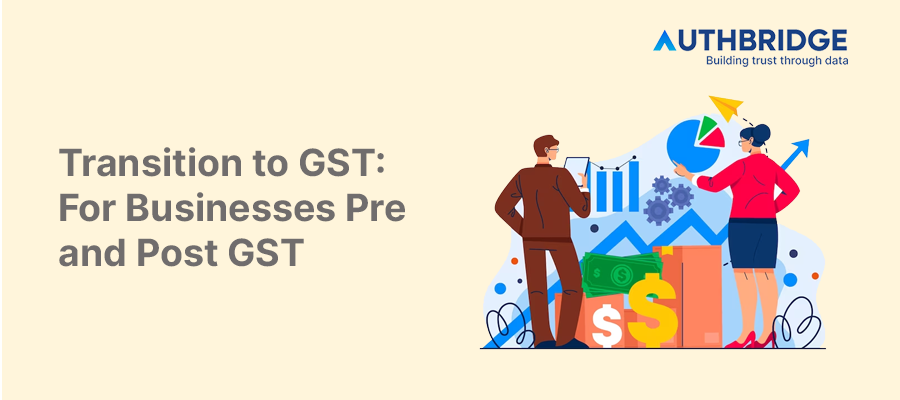GST Transition: A Pre & Post Implementation Guide For Businesses

The Goods and Services Tax (GST) represents a significant overhaul of the indirect tax regime in India, consolidating multiple taxes into a single tax system. This transition aimed to make the tax system more transparent, reduce tax evasion, and make compliance easier for businesses. However, transitioning to GST required businesses to understand the new tax structure, update their accounting and billing systems, and manage their input tax credit effectively.
Importance of Smooth Transition for Businesses
A smooth transition to GST was crucial for businesses to ensure compliance, minimize disruption to operations, and leverage the benefits of the GST regime, such as the seamless flow of input tax credit. Businesses needed to meticulously plan and execute their transition strategy, addressing aspects like registration, inventory management, and staff training to navigate the change effectively.
Preparing for GST Transition
Understanding GST and Its Impact
The first step for businesses in preparing for the GST transition was to understand the new tax structure and how it would impact their operations, pricing, and profitability. GST subsumed various central and state taxes into a single tax, aiming to eliminate the cascading effect of taxes and make the Indian market more unified and competitive.
Inventory and Working Capital Management
Businesses needed to assess their inventory levels closely, as the GST transition impacted the tax treatment of existing stock. It was crucial to evaluate the input tax credit available on the closing stock and plan purchases and production to optimize tax credits and working capital.
Aspect | Pre-GST | Post-GST |
Inventory Valuation | Based on multiple taxes | Unified under GST |
Working Capital | Could be higher due to cascading taxes | Potentially lower due to seamless ITC |
Training and Awareness for Staff
Ensuring that the staff was well-informed about GST and its implications was another critical step. Training sessions, workshops, and seminars helped in building awareness and preparing the team for the operational changes required under GST.
Key Steps in GST Migration
Registration and Migration to GST
All businesses exceeding the turnover threshold had to register under GST. The migration process involved obtaining a new GST registration number (GSTIN) and updating it across all business processes.
Task | Description |
GSTIN Registration | Mandatory for businesses with turnover above the threshold |
Update Systems | Incorporate GSTIN in invoices, receipts, and financial documents |
Managing Transitional Input Tax Credit (ITC)
A significant aspect of the GST transition was managing the input tax credit on the existing stock and capital goods. Businesses could carry forward the credit from the previous tax regime to GST, subject to certain conditions.
Condition | Eligibility for ITC |
Closing Stock | Credit available if documented and eligible under GST |
Capital Goods | Partial credit carried forward, subject to GST rules |
Compliance Requirements Under GST
Post-transition, businesses had to adhere to new compliance requirements, including monthly and annual returns, digital invoicing, and maintaining detailed records for audit purposes.
Compliance Aspect | Requirement |
Returns Filing | Monthly and annual GST returns |
Digital Compliance | E-invoicing for businesses above a certain turnover |
Transitional Provisions
Input Tax Credit for Closing Stock
Businesses were allowed to claim input tax credit on the closing stock held as of the transition date, provided the stock was purchased within the last one year and was used for taxable supplies under GST.
Treatment of Existing Contracts and Unfinished Goods
For ongoing contracts and unfinished goods, businesses needed to assess the GST impact and renegotiate terms if necessary, to factor in the new tax rates and input tax credit provisions.
Special Considerations for Service Providers
Service providers had to pay special attention to the place of supply rules under GST, which determined the applicable tax rate and state for tax payment, significantly impacting the tax liability and compliance.
Post-GST Transition Strategies
Adapting Business Processes to GST
Post-transition, businesses had to continuously adapt their processes, accounting, and IT systems to comply with GST regulations, optimize tax credits, and ensure seamless operations.
Leveraging Technology for GST Compliance
Technology played a crucial role in managing GST compliance efficiently. Investing in GST-compliant software helped businesses automate tax calculations, return filings, and compliance checks.
Continuous Monitoring and Compliance
Regular monitoring of GST filings, tax payments, and compliance status was essential to avoid penalties and ensure smooth business operations. Businesses also needed to stay updated with changes in GST laws and regulations.
Challenges and Solutions
Common Challenges Faced by Businesses
Transition challenges included understanding the new tax regime, updating IT systems, managing cash flow impacts due to changes in tax rates, and ensuring compliance with new procedural requirements.
Strategies to Overcome Transition Challenges
Effective strategies included investing in GST training for staff, adopting GST-compliant software, consulting tax experts for complex issues, and maintaining robust documentation for all transactions.
Conclusion
Summary of Key Points
The transition to GST was a landmark change for Indian businesses, requiring careful planning and execution. While it presented challenges, it also offered opportunities for simplification, efficiency, and growth in the long run.
Looking Ahead: GST Compliance and Business Growth
As businesses continue to adapt to the GST regime, staying compliant and leveraging the benefits of the unified tax system will be key drivers for sustainable growth and competitiveness in the market.
Category

Abhinandan Banerjee
(Associate Manager - Marketing)
Abhinandan is a dynamic Product and Content Marketer, boasting over seven years of experience in crafting impactful marketing strategies across diverse environments. Known for his strategic insights, he propels digital growth and boosts brand visibility by transforming complex ideas into compelling content that inspires action.



